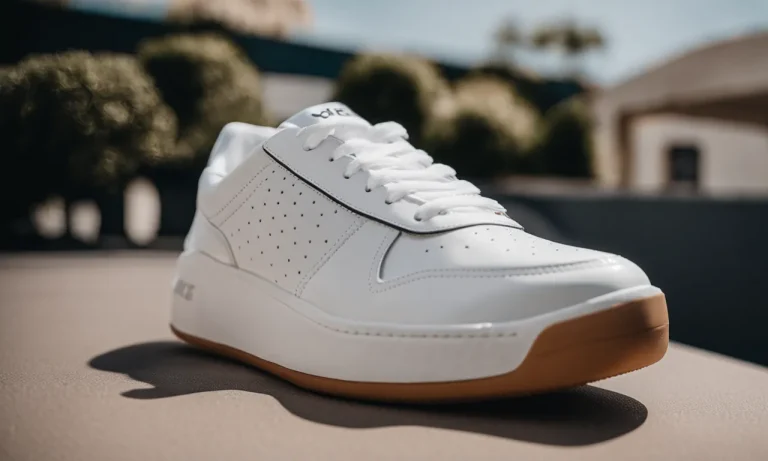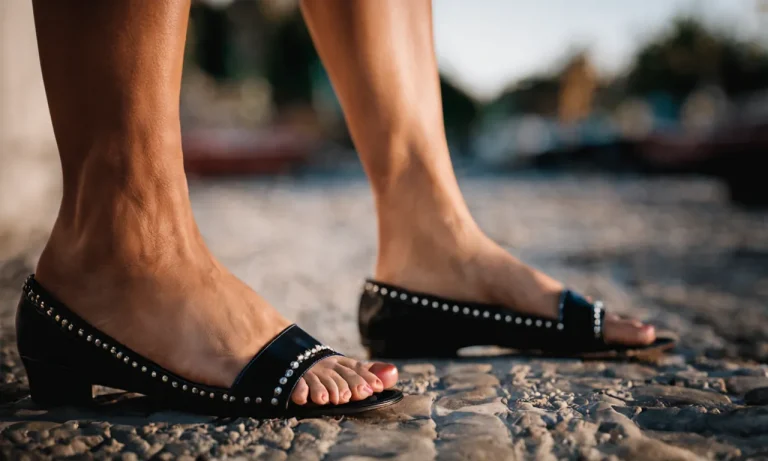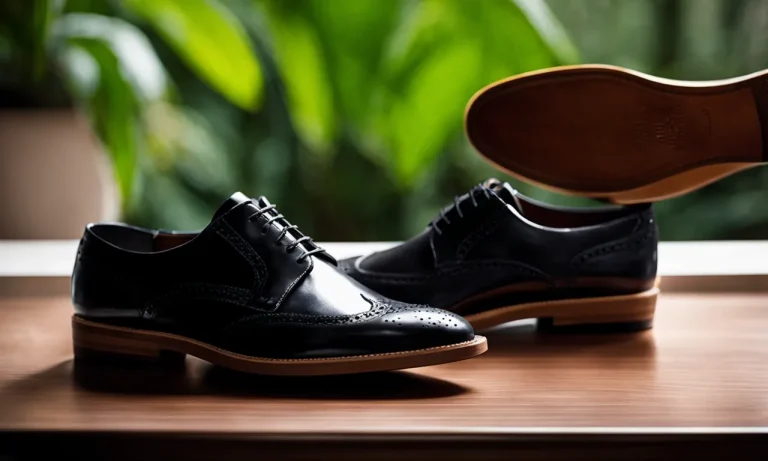When shopping for winter boots, one of the most common questions people have is whether they should buy a size larger than their normal shoe size. There are some good reasons why sizing up may be a smart strategy when it comes to winter footwear.
If you’re short on time, here’s a quick answer to your question: Most experts recommend buying winter boots 1/2 to 1 full size larger than your normal shoe size. This allows room for thick socks while still ensuring a comfortable fit.
Why You May Want Bigger Winter Boots
When it comes to buying winter boots, it’s important to consider the size carefully. While some people may opt for their usual shoe size, there are several reasons why you may want to go for a bigger size. Here are a few factors to consider:
Accommodate Thicker Socks
During the winter months, it’s common to wear thicker socks to keep your feet warm and cozy. If you buy winter boots that are too snug, you may find it difficult to wear thicker socks comfortably. By opting for a bigger size, you’ll have enough room to accommodate those cozy winter socks without compromising on comfort.
Allow for Toe Wiggle Room
No one wants their toes to feel cramped and uncomfortable in their winter boots. By choosing a bigger size, you’ll allow for more toe wiggle room. This extra space can help prevent blisters, corns, and other foot issues that can arise from tight-fitting boots.
Remember, a little extra room can go a long way in ensuring your feet stay happy and healthy.
Account for Feet Expanding in Cold
Did you know that your feet can actually expand in the cold? When exposed to colder temperatures, blood vessels constrict, and this can cause your feet to swell. By sizing up, you can account for this natural expansion and ensure your boots still fit comfortably even in the chilliest of weather.
Fit Growing Kids’ Feet
For parents buying winter boots for their children, it’s important to consider their rapidly growing feet. Kids’ feet can grow quickly, and buying boots that are slightly bigger can allow room for growth.
This way, you won’t have to replace their boots too soon, saving you time and money in the long run.
Cushion for Orthotics or Insoles
If you wear orthotics or insoles for added support or comfort, you may need a bit more space in your winter boots. These inserts can take up some room inside the shoe, so opting for a bigger size can ensure a better fit.
Additionally, a larger boot can provide more cushioning and support for your feet, reducing fatigue and discomfort throughout the day.
Factors to Consider When Sizing Up
Boot Style and Intended Use
When determining whether you should size up when buying winter boots, the first factor to consider is the boot style and its intended use. Different boot styles are designed with different fits and purposes in mind.
For example, if you’re looking for a pair of snowshoeing boots, you may want to size up to accommodate thicker socks and provide extra room for your feet to move. On the other hand, if you’re buying fashion boots or casual winter boots, going up a size may not be necessary as these boots typically have a more relaxed fit.
Your Foot Shape
Another important factor to consider is your foot shape. Everyone’s feet are unique, and certain boot styles may fit better with specific foot shapes. If you have wide feet or a high arch, you may find that sizing up allows for a more comfortable fit.
Conversely, if you have narrow feet, going up a size may result in a loose and uncomfortable fit.
Trying On Boots with Appropriate Socks
When trying on winter boots, it’s important to wear the type of socks you would typically wear with them. For example, if you plan on wearing thick wool socks during the winter, make sure to try on the boots with those socks to ensure a proper fit.
Socks can greatly affect the fit of the boots, so it’s important to take this into consideration when deciding whether to size up.
If You’ll Be Wearing Orthotic Insoles
If you require orthotic insoles for additional support or comfort, it’s essential to consider this when sizing up your winter boots. Orthotic insoles can take up extra space inside the boot, so you may need to size up to accommodate them properly.
It’s recommended to try on boots with your orthotic insoles to ensure they fit comfortably.
Weather Conditions You’ll Be In
The weather conditions you’ll be facing during the winter season should also play a role in determining whether you should size up when buying winter boots. If you’ll be in extremely cold temperatures or wet conditions, you may want to consider sizing up to allow for extra insulation or to accommodate thicker socks.
Additionally, if you’ll be trekking through deep snow or icy terrain, you may want the added stability and support that a slightly larger boot size can provide.
Remember, it’s always a good idea to try on multiple sizes and styles of winter boots to find the perfect fit for your feet. Don’t hesitate to seek guidance from knowledgeable sales associates or consult online resources for specific brand sizing charts and recommendations.
How Much Bigger to Size Up
When it comes to buying winter boots, considering the right size is crucial for comfort and functionality. But should you size up when purchasing winter boots? Let’s explore how much bigger you should go to ensure optimal fit and insulation.
1/2 Size Up for Light Insulation
If you’re opting for winter boots with light insulation, such as those designed for mild winter conditions or occasional outdoor activities, it is generally recommended to size up by half a size. This small increase in size allows extra room for thicker socks or additional insoles, ensuring your feet stay warm and comfortable without compromising on fit.
1 Full Size Up for Heavy Insulation
For winter boots with heavy insulation, like those intended for extreme cold weather or prolonged outdoor adventures, sizing up by a full size is often advised. These boots often have thicker insulation layers, which can make them feel more snug.
By going up a full size, you provide ample space for proper insulation and circulation, reducing the risk of cold feet and discomfort.
Go By Manufacturer’s Recommendations
While general guidelines can be helpful, it’s essential to pay attention to the manufacturer’s recommendations. Different brands might have specific sizing instructions based on their unique designs and materials.
Checking the manufacturer’s guidelines or consulting their customer support can provide valuable insights into the ideal sizing for their winter boots.
Size Up Only in Length, Not Width
When sizing up, it’s important to focus on length rather than width. Winter boots are typically designed with a wider toe box to accommodate thicker socks and maintain proper circulation. Therefore, sizing up in width may result in a loose fit, which can lead to discomfort and instability while walking.
Aim for Snug But Not Too Tight Fit
Ultimately, the goal is to find a snug but not overly tight fit when choosing winter boots. A properly fitting boot should allow you to wiggle your toes comfortably and have enough room to add extra insulation if needed.
It’s worth trying on boots with different sizes and styles to find the perfect fit for your feet.
Remember, everyone’s feet are unique, and individual preferences may vary. It’s essential to listen to your own comfort and make adjustments accordingly. When in doubt, consult the manufacturer’s recommendations, seek advice from experts, or visit a reputable footwear store for professional fitting assistance.
Tips for Getting the Right Winter Boot Fit
Try Boots On at the End of Day When Feet Are Largest
When shopping for winter boots, it’s important to keep in mind that our feet tend to swell throughout the day. To ensure a proper fit, it’s recommended to try on boots at the end of the day when your feet are at their largest.
This will help you avoid purchasing boots that may feel tight or uncomfortable during the colder months. By trying on boots when your feet are at their largest, you can ensure a comfortable fit all day long.
Wear Socks You Plan to Wear with Boots
Another helpful tip when trying on winter boots is to wear the socks you plan to wear with them. Different socks can affect the fit of the boots, so it’s important to take this into consideration. If you typically wear thick socks during the winter, make sure to wear them when trying on boots.
This will help you determine if the boots are the right size and if there is enough room for your feet to move comfortably.
Walk Around Store with Boots On
Don’t just stand and look in the mirror when trying on winter boots. Take a few laps around the store to get a feel for how the boots fit and how they support your feet. Walking around will give you a better idea of the comfort level and whether there are any areas that may rub or cause discomfort.
It’s important to find boots that provide both comfort and support, especially if you plan on wearing them for extended periods of time.
Consider Insoles You’ll Use
If you use special insoles or orthotics, it’s important to take them into consideration when trying on winter boots. Some boots may have limited space for additional inserts, so it’s essential to make sure there is enough room to accommodate your insoles.
Consider the thickness and size of your insoles when selecting the right boot size. This will help you ensure a proper fit without sacrificing the support and comfort provided by your inserts.
Order from Retailer with Good Return Policy
Lastly, if you’re purchasing winter boots online, it’s important to choose a retailer with a good return policy. Sometimes, despite our best efforts, the boots we order may not fit perfectly. In such cases, having the option to return or exchange the boots can make the buying process much less stressful.
Before making a purchase, carefully review the retailer’s return policy to ensure you have the option to exchange or return the boots if needed.
Conclusion
Finding properly fitted winter boots is important for comfort and performance. While sizing up is recommended, be sure not to go more than 1 full size up from your normal shoe size. The right pair of winter boots will have some wiggle room but still feel snug and secure.
Following the tips above will help you find winter boots that are a perfect fit while keeping your feet warm and dry all season long.






